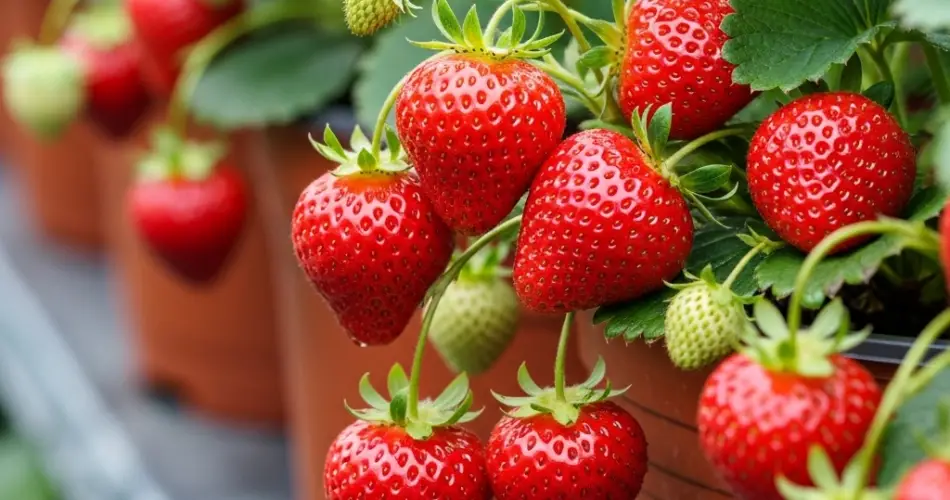Strawberries are among the most beloved fruits worldwide, prized for their sweet flavor and versatility in desserts, salads, and snacks. Growing strawberries at home is highly rewarding, especially when you have limited space, such as in an urban environment. Container gardening offers an excellent way to cultivate strawberries successfully, even on balconies, patios, or small gardens.
If you dream of harvesting thousands of strawberries from pots, this guide will walk you through the essential steps to plant, care for, and maintain your strawberry plants in containers to maximize fruit production and keep your plants healthy.
Why Grow Strawberries in Pots?
Growing strawberries in pots or containers provides several advantages:
-
Space Efficiency: Ideal for apartments or small outdoor spaces.
-
Pest and Disease Control: Easier to monitor and manage.
-
Mobility: Pots can be moved to optimize sunlight exposure or protect plants from adverse weather.
-
Soil Control: You can use high-quality, well-draining soil tailored to strawberries’ needs.
With the right care and setup, strawberry plants grown in pots can yield abundant, juicy berries season after season.
Choosing the Right Containers and Soil
For best results, select pots or containers with adequate drainage holes to prevent waterlogging, which can cause root rot. Containers should be at least 12 inches (30 cm) deep to accommodate root growth.
Use a high-quality potting mix rich in organic matter and well-draining. A mixture of peat moss, compost, and perlite or vermiculite works well. Avoid heavy garden soil, which can compact and suffocate roots.
Selecting Strawberry Varieties for Container Growing
Some strawberry varieties perform better in pots due to their size and growth habits. Consider:
-
Day-neutral varieties: Produce fruit throughout the growing season, providing continuous harvests.
-
Ever-bearing varieties: Yield two main harvests, one in spring and another in late summer or fall.
-
June-bearing varieties: Produce one large harvest in early summer but may require more space.
Popular day-neutral varieties like ‘Seascape’ and ever-bearing types like ‘Quinault’ are well-suited for container growing.
Planting Strawberries in Pots
-
Prepare the soil: Fill your container with the potting mix, leaving about an inch from the top.
-
Plant spacing: Place strawberry plants 6 to 8 inches (15-20 cm) apart to allow airflow and growth.
-
Plant depth: Ensure the crown (where leaves emerge) sits just above the soil surface. Planting too deep or too shallow can harm the plant.
-
Water gently: After planting, water well to settle the soil around roots.
-
Mulch: Use straw or shredded leaves on top of the soil to retain moisture and reduce weed growth.
Essential Care Tips for Thriving Strawberry Plants
Watering
Strawberries need consistent moisture but dislike soggy soil. Water your container plants regularly, especially during hot or dry weather. The soil should be moist but not waterlogged. Early morning watering is ideal to reduce fungal risks.
Fertilizing
Feed your strawberry plants with a balanced, slow-release fertilizer formulated for fruiting plants. Alternatively, organic options like compost tea or diluted fish emulsion can provide essential nutrients. Fertilize every 3-4 weeks during the growing season to support flower and fruit development.
Sunlight
Strawberries require at least 6 hours of direct sunlight daily to produce sweet, flavorful berries. Place your pots in the sunniest spot available, such as a south-facing balcony or patio.
Pruning and Runner Management
Remove dead or yellow leaves to keep plants healthy and prevent disease. Strawberry plants produce runners—long stems that develop baby plants. You can trim runners to encourage the main plant’s energy towards fruit production, or propagate new plants by rooting runners in separate pots.
Dealing with Common Challenges
-
Pests: Watch for aphids, spider mites, and slugs. Use organic insecticidal soap or natural predators like ladybugs for control.
-
Diseases: Prevent fungal diseases by avoiding overhead watering and providing good air circulation. Remove any diseased leaves promptly.
-
Pollination: While strawberries are self-pollinating, outdoor plants benefit from bee activity. If growing indoors, consider hand-pollinating flowers with a soft brush.
Harvesting Your Strawberries
Strawberries are ready to harvest when fully red, juicy, and fragrant. Pick berries gently to avoid damaging the plant. Harvest every few days during peak season to encourage continuous production.
Proper harvesting also reduces fruit spoilage and keeps your plants productive.
Extending Your Strawberry Harvest
To enjoy strawberries longer, consider:
-
Growing different varieties with staggered fruiting times.
-
Providing shade during extreme heat to prevent fruit sunburn.
-
Protecting plants from early frost by moving pots indoors or covering them.
Conclusion
Growing thousands of strawberries in pots is achievable with proper care, the right planting techniques, and attention to your plants’ needs. Container gardening offers urban growers a chance to enjoy fresh, homegrown strawberries without requiring a large garden.
By selecting the right variety, maintaining good watering and fertilizing habits, and managing pests and diseases, your potted strawberry plants will flourish and reward you with bountiful harvests.
Start your strawberry container garden today and delight in the sweet taste of homegrown fruit, right on your balcony or patio!



